Long-leaved lacebark facts for kids
Quick facts for kids Long-leaved lacebark |
|
|---|---|
 |
|
| Scientific classification | |
| Genus: |
Hoheria
|
| Species: |
sexstylosa
|
The Long-leaved lacebark, also known as ribbonwood, is a beautiful tree from New Zealand. Its scientific name is Hoheria sexstylosa. This plant is special because it's endemic to New Zealand, meaning it naturally grows nowhere else in the world! It belongs to the Malvaceae family, which also includes plants like hibiscus and cotton.
Contents
What is the Long-leaved Lacebark?
This amazing plant can grow as an evergreen tree or a large shrub. Being evergreen means it keeps its leaves all year round, even in winter. It can reach up to 8 meters (about 26 feet) tall and spread out about 6 meters (about 20 feet) wide.
Appearance and Special Features
The Long-leaved lacebark has glossy green leaves that look very healthy. In summer and autumn, it produces many lovely white flowers. These flowers make the tree look even more beautiful. This tree often has a graceful, weeping shape, almost like its branches are gently flowing downwards. Because of this, nurseries sometimes sell it under the name 'graceful lacebark'.
The Latin part of its name, sexstylosa, is interesting! It means "six styles". A style is a part of a flower's reproductive system. So, this tree's flowers usually have six of these styles.
Where Does it Grow?
The Long-leaved lacebark is native to New Zealand. In the North Island, you can find it growing naturally from the Waikato and Coromandel Peninsula areas all the way south to Wellington. In the South Island, natural groups of these trees are found in North West Nelson, inland Marlborough, and on the Banks Peninsula. Sometimes, you might see it growing in other places, but those populations might have been planted there by people, rather than growing naturally.
How is it Grown?
People often plant the Long-leaved lacebark in gardens because it's so attractive. It can handle cold weather and frost quite well, but it prefers a spot that is a bit sheltered from strong winds.
There's a special type of this tree called a cultivar named 'Stardust'. This 'Stardust' variety is very popular and has even won an important award called the Royal Horticultural Society's Award of Garden Merit. This award means it's a great plant for gardens and is easy to grow successfully.

